

Roy Collins was born on the 8th May 1916 at Oliver Street, in the 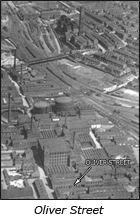 Parish district of St Peters, Oldham, Lancashire.
Parish district of St Peters, Oldham, Lancashire.
Oliver Street was on the South side of the town in an area (like many in Oldham around the early 1900's) which was heavily industrialised.
The industry consisted mainly of cotton spinning and small light engineering works and a map of the area at that time shows the numerous mills and factories nearby, including The Globe Meter Works, Wellington Works and Vale Cotton Mill which overlooked the house.
Most of the factories have long since been demolished and Oliver Street no longer exists, the site now being occupied by a Sainsbury supermarket and a multi-storey car park.
Roy was the second child of Fred and Sarah Collins (nee Burslem) who were both born and raised in Oldham.
At the time when Roy was born Fred was serving in the 3rd (Reserve) Garrison Battalion of the Suffolk Regiment after being 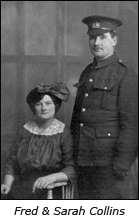 discharged from the 24th Battalion Manchester Regiment (Oldham Pals) following an injury. Until he was finally discharged from the reserves in 1919 Roy saw very little of his father except when he returned home on leave.
discharged from the 24th Battalion Manchester Regiment (Oldham Pals) following an injury. Until he was finally discharged from the reserves in 1919 Roy saw very little of his father except when he returned home on leave.
When he finally returned home at the end of WWI, Fred worked (like his father Albert before him) as a wholesale fruit and vegetable merchant and Sarah would later become a shopkeeper in the same type of business.
Their first born child Emily sadly died at the age of five from Scarlet Fever, two years before Roy was born. This illness caused devastating epidemics through the early 20th century and killed a high percentage of those infected.
Roy was a pupil at St Peters school on Union St, Oldham which according to a gazetteer of 1904 was built in 1835 to accommodate 800 children.
School life then was very much different to today. The school bell heralded the start of each day which started at nine and ended at four o' clock. Class sizes averaged around forty pupils, sat on long desks with bench like wooden seats. Discipline was very strict and the cane or leather strap was quite frequently used to punish disobedient pupils.
Not much is known about Roy's life during 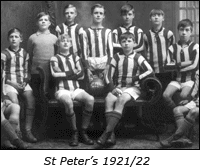 his school days except that he was always keen to participate in sports, particularly football and cricket. He was a member of the school football team at the age of ten. On the team photo for 1927/28 Roy is second from the left.
his school days except that he was always keen to participate in sports, particularly football and cricket. He was a member of the school football team at the age of ten. On the team photo for 1927/28 Roy is second from the left.
Cricket and Rugby League were his favourite spectator sports and he often talked about the times when he went with his father to watch the Oldham teams playing cricket at the Pollards ground and Rugby League at the Watersheddings.
In the early part of the twentieth century families were brought up to observe strict moral principles and many were encouraged to 'take the pledge' to observe the total abstinence of alcohol.
Roy's grandfather Albert was a staunch supporter of the Temperance Movement and in the late 1800's was President of the Temperance Society which met at the Temperance Hall in Horsedge Street Oldham. In common with a lot of children at 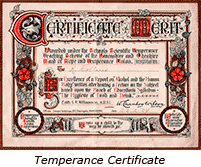 that time Roy attended lectures on Temperance values and was awarded a Certificate for writing a report on "Alcohol and the Human Body".
that time Roy attended lectures on Temperance values and was awarded a Certificate for writing a report on "Alcohol and the Human Body".
As a result of the increased influence of the temperance movement, home brewed non-alcoholic drinks became increasingly popular. They were served at the many temperance bars and at over thirty herbalist shops throughout the town. Roy often recalled how he would meet with friends at the popular shop on George Street (run by Joe Mawson) for a pint of Sass n' Soda or a herb beer.
He left St Peters School in 1930 at the age of 14 (in 1918, the school leaving age was raised to 14 years) and began working for his mother and father. He wanted to work as a vehicle mechanic but didn't have the necessary qualifications so he worked during the day and then attended night school classes at the Technical college on Ascroft Street to study vehicle engineering.
The family moved to Roundthorn Road in 1931 where Roy's mother Sarah ran a fruit and vegetable shop. At that time Fred worked in the wholesale fruit and vegetable business. He had previously worked at the Wellington Street business run by his father Albert until his death in 1908.
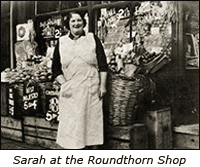 Although Roy would spend much of his time helping his mother in the shop he often accompanied his father to the wholesale market in Smithfield Manchester. Starting at four in the morning, the journeys would take several hours and they would return with their transport laden with fresh fruit and vegetables In earlier times Fred had made the journey with horse drawn carts but by the early 1930's motor transport was becoming more widely used. They also made regular trips to the Clegg Street Railway Goods yard to collect fruit which had been transported directly from the docks at Liverpool.
Although Roy would spend much of his time helping his mother in the shop he often accompanied his father to the wholesale market in Smithfield Manchester. Starting at four in the morning, the journeys would take several hours and they would return with their transport laden with fresh fruit and vegetables In earlier times Fred had made the journey with horse drawn carts but by the early 1930's motor transport was becoming more widely used. They also made regular trips to the Clegg Street Railway Goods yard to collect fruit which had been transported directly from the docks at Liverpool.
Roy's mother Sarah was also born in Oldham to a stonemason named George William Burslem. The connection has yet to be proved but according to several Census records, he originated from New York USA.
During the summer months all the cotton mills in Lancashire would close for the traditional wakes week (later to become a two week break). Each of the mill towns would nominate a week during which the cotton mills would all close at the same time. This week then became the focus for fairs, and eventually for holidays where the workers would go to the seaside, traditionally Blackpool, eventually on the newly developed railways.
On several occasions Roy and his family ventured further afield during this holiday period, taking one of the many steamers from Fleetwood or Liverpool to the Isle of Man. Fred and Sarah had travelled to Douglas on more than one occasion before Roy was born and this became almost a traditional destination for the family.
In his teenage years Roy did not have the opportunity to travel or socialise as much as younger people do today and most of his leisure time was centred around his family. One of his best friends at that time was Sam Armitage. Sam was also a good friend of the family and he and Roy would remain good friends for many years. Another dear friend in Roy's life at that time was their dog, a Bedlington Terrier named Roddy.
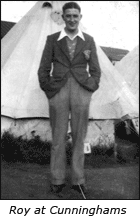 In the late 1930's Roy shunned the popular seaside resorts along the west coast such as Southport, Blackpool and Morecambe to continue his trips to the Isle of Man. However, he no longer stayed in the guest houses where he had previously stayed with his mother and father. Another new and increasingly popular destination at the time was Cunningham's Young Men's Holiday Camp on the Isle of Man, sometimes regarded as the forerunner to the holiday camps popular on the mainland in the fifties and sixties.
In the late 1930's Roy shunned the popular seaside resorts along the west coast such as Southport, Blackpool and Morecambe to continue his trips to the Isle of Man. However, he no longer stayed in the guest houses where he had previously stayed with his mother and father. Another new and increasingly popular destination at the time was Cunningham's Young Men's Holiday Camp on the Isle of Man, sometimes regarded as the forerunner to the holiday camps popular on the mainland in the fifties and sixties.
But this was no Butlins or Pontins especially as accommodation was under canvas. Over a thousand bell shaped tents provided accommodation for men only at the Victoria Road Douglas site. According to the Douglas Centenary a tent could sleep up to eight men, spring beds being placed on a wooden floor (lifted every ten days for cleaning).
The main reason for choosing the Isle of Man wasn't just for the novelty of a 'distant' destination but to go and watch the spectacle of the TT motorcycle races. Roy was a motorcycle enthusiast at that time and he and Sam would travel around the island watching the racing from all the popular spectator viewpoints.
On the outbreak of the Second World War, Parliament passed the National Service (Armed Forces) Act, under which all men between 18 and 41 were made liable for conscription. The registration of all men in each age group in turn began on 21st October 1939. It was also announced that single men were to be called up before married men. Those aged 20 to 23 were the first who were required to register and by May 1940, registration had extended as far as men aged 27. This long and drawn-out process continued until all 40-year-olds had been registered in June 1941.
Roy enlisted with the Royal Army Ordnance 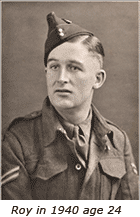 Corps in June 1940 aged 24.
Corps in June 1940 aged 24.
The story of Roy's military service is described in detail elsewhere in this website and can be found in the main navigation menu or by following this link.
When Roy returned home to Afghan Street in 1945 he was in poor health mentally and physically but his torment continued when he learned that his father Fred had died three years earlier. This was devastating news to him because in the letters his mother wrote to him as a POW she didn't disclose this sad news, in fact all the letters closed with the words "your ever loving Mother and Father".
In the first few years following his discharge from the Army, he tried hard to rebuild his life but the illnesses and mental torture he had suffered in the Far East were never far away. The tropical diseases had taken their toll and for a number of years he was very poorly especially with recurring bouts of Malaria. Local doctors at that time had very limited knowledge of tropical diseases and eventually he became hospitalised and underwent treatment at the Liverpool School of Tropical Medicine where pioneering treatments were being evaluated for Malaria. Even though the initial treatments were of immediate benefit, he would return there many times up until his seventies.
For several years he lived with his mother who now lived in Afghan Street. Following the death of her husband Fred in 1942 Sarah had struggled to maintain the greengrocers shop in Roundthorn Road and she eventually sold the business in 1944.
It was shortly after the war ended when Roy met Dorothy (Bardsley) for what would be the start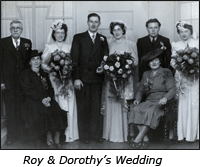 of a relationship which lasted over sixty years. They first met at a Saturday night dance at Froggats (one of the many dance halls in Oldham) where the entrance fee was 1/6d and 1/- for uniformed personnel. After a courtship of just a few months they were married on 8th Dec 1946 at Springhead Congregational Church. Their best man was Roy's best friend Sam Armitage.
of a relationship which lasted over sixty years. They first met at a Saturday night dance at Froggats (one of the many dance halls in Oldham) where the entrance fee was 1/6d and 1/- for uniformed personnel. After a courtship of just a few months they were married on 8th Dec 1946 at Springhead Congregational Church. Their best man was Roy's best friend Sam Armitage.
For the first eighteen months of their marriage they lived with Roy's mother Sarah in Afghan Street. Then in 1948 they moved into their first home together in Balfour Street.
On their first holiday together they made a nostalgic trip (for Roy) back to the Isle of Man and the TT races, only this time the accommodation was somewhat better than the bell tents which Roy remembered from his teenage years.
Roy's first job in civvy street was with A V Roe where he was involved in the assembly of aircraft parts. He maintained this job for several years but factory life was not for him. He longed for a job outdoors and to run his own business. The factory was some miles away and the journey to and from work took some time, changing buses en route. Roy started to save for an alternative method of transport which he bought in 1948 - a BSA Bantam motorcycle.
In December of that year their first son Stuart was born followed by the birth of Raymond in April 1950.
Like his mother and father before him Roy always wanted to run his own business and in 1953 they moved from Balfour Street to Oswald Street in Chadderton where they bought a mixed grocery business. Dorothy was completely new to running a business so Roy helped her set things up for a few months. After that time Dorothy would run the business during the day while Roy worked as a delivery driver for Robinsons in Chadderton. Part of his job would involve a four o'clock start to travel to the Fylde Coat and Knott End where he would collect boxes of fresh eggs from local farmers.
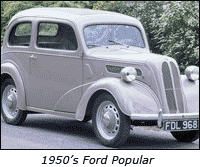 In 1955 he traded his bike for his first motor car - a Ford Popular. Due to the six year halt in production caused by World War II there were no late-model used cars available. Unless the purchaser could pay the extra hundred pounds or so for an Anglia 100E, Austin A30 or Morris Minor, the choice was the Popular or a pre-war car.
In 1955 he traded his bike for his first motor car - a Ford Popular. Due to the six year halt in production caused by World War II there were no late-model used cars available. Unless the purchaser could pay the extra hundred pounds or so for an Anglia 100E, Austin A30 or Morris Minor, the choice was the Popular or a pre-war car.
It had a top speed of 60 mph and could accelerate from 0-50 mph in 24.1 seconds. Although the cost in 1955 was around £400 including taxes. today they are classic collectors cars with restored models selling for over £4000.
The vehicle was surprisingly reliable and economical and allowed the family to holiday further afield than the Lancashire coastal towns. One of their first long journeys in the vehicle was to visit relatives in Torquay which they combined with a holiday in Brixham Devon. At that time there were no motorways and the journey took many hours starting at 5 pm, traveling overnight and arriving at around 10 am the next day. They so enjoyed the milder climate of the south west coast that the family holidayed in Brixham and nearby resorts many times during the fifties and early sixties.
In 1957 Roy visited an old friend Bill Owen who at that time was working for himself on roofing contracts. He persuaded Roy to join him and they formed a working partnership which would last for the next two years. They worked long hours on small and large contracts throughout the North West of England and parts of North Wales.
In 1959 the Collins family were on the move again, this time to a newly built house in Lydgate Drive, Oldham. It was also around this time that his friend Bill Owen became ill and had to give up working and as a result their successful partnership ended. However, Roy continued to work as a roofer with Andersons (and later with Vulcanite) in Trafford Park for several more years.
Roy had always been very close to his mother Sarah and it took him some time to come to terms with her death in 1960 after a long illness.
After only three years in their new home Roy and Dorothy realised that they needed more space for a growing family and they moved again in 1962 to Foster Street, Clarksfield, where they would live for the next 45 years.
In 1962 Roy's health began to deteriorate. Repeated episodes of high fever were diagnosed as relapsing malaria and he once more had to visit the School of Tropical Medicine in Liverpool for treatment. His illness brought with it other symptoms including severe depression. Because of his illness he had to give up his job as a roofer.
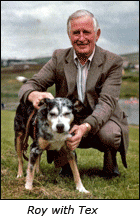 In his characteristic manner, over the next few years he slowly recovered to rebuild his life once again. He changed the familiarity of his job as a roofer with that of an Insurance agent, which he would follow for the next eighteen years up until his retirement.
In his characteristic manner, over the next few years he slowly recovered to rebuild his life once again. He changed the familiarity of his job as a roofer with that of an Insurance agent, which he would follow for the next eighteen years up until his retirement.
During his fightback to health he tried to stay as active as possible and one of his more enjoyable pastimes was swimming. His twice weekly visits to the Central baths on Union Street, Oldham with his friend Alf certainly went a long way in aiding his recovery.
He also found a friend in his new pet dog Tex, a Blue Merle Collie from a local farm. Every day they would walk for miles together and this gave Roy a great boost both mentally and physically.
From the time when he served in the Army up to the present day he had 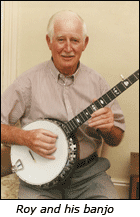 always had a love of playing the banjo and he especially liked the music of the 'Ragtime' era. It was during the late sixties when he achieved a lifelong ambition to play in a band for it was at that time he joined the Oldham Banjo Band which was led by an old friend of his, Jack Taylor. For a number of years they would rehearse during the week and play most weekends at a variety of venues in and around Oldham.
always had a love of playing the banjo and he especially liked the music of the 'Ragtime' era. It was during the late sixties when he achieved a lifelong ambition to play in a band for it was at that time he joined the Oldham Banjo Band which was led by an old friend of his, Jack Taylor. For a number of years they would rehearse during the week and play most weekends at a variety of venues in and around Oldham.
In the seventies Roy's two grandsons Jamie and Simon were born and throughout the rest of his life they would become almost inseparable. Every weekend, come rain or shine he would take them on walks or day trips to the seaside and for many years he would enjoy their company on holidays both at home and abroad.
From an early age he introduced them to Rugby League at Watersheddings and for several years they followed Oldham to every match home and away, to venues as far afield as Carlisle, Workington and Whitehaven as well as the many other clubs in the Lancashire and Yorkshire region.
Rugby League at that time was a sport played during the winter months and during the summer he would switch his allegiance to his other passion - cricket.
Roy was a lifelong member at Lancashire CC and enjoyed many memorable matches at Old Trafford. On many occasions his grandsons would accompany him, especially for the Roses matches against Yorkshire.
From shortly after the time of his discharge from the Army in 1946 he had been a member of the FEPOW (Far East Prisoner of War Association). Their motto is "To keep going the spirit that kept us going". Their aims were to address welfare concerns of ex POW's, obtain compensation for the suffering endured whilst a prisoner of the Japanese and to obtain an apology for their mistreatment from the Japanese Government. For a number of years Roy was an active campaigner seeking to address these issues. The survivors of the atrocities never received a formal apology but in 2001 were awarded compensation from the British Government.
Roy retired in 1981 at the age of 65. Despite his earlier setbacks he had remained active throughout his working life and was physically fit for his age. However he still bore the mental scars from his earlier years in captivity. He seldom talked about his time as a PoW. It was as if he wanted to shut out the pain and suffering. It may be taken for granted today that anyone who has suffered loss and hardship - let alone torture - will need `counseling', but back in 1945 it was expected that a stiff-upper lip would suffice to hide the absolute horror of it. As many ex PoW's have said "You never, ever forget.”
During their retirement Roy and Dorothy enjoyed many holidays abroad and made many new friends. One of their favourite destinations was Cyprus where they returned many times. They also spent a lot of time holidaying in Wales with their grandsons. Roy loved to be in the mountains of Snowdonia where he enjoyed the peace and solitude walking many of the high peaks and ridges.
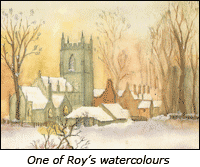 Roy was a wonderful, talented man who succeeded at most things. After he retired he became interested in drawing and painting. Initially self taught, he later started to attend art classes at the Oldham Lyceum where he learned a great deal and made many friends. At first he was interested in painting with oils but after a few months he switched to watercolours. He loved to paint landscapes of the places he visited (from sketches he would make at the time) and produced literally hundreds of fine paintings. During his time studying at the Lyceum he also received several commendations for his work.
Roy was a wonderful, talented man who succeeded at most things. After he retired he became interested in drawing and painting. Initially self taught, he later started to attend art classes at the Oldham Lyceum where he learned a great deal and made many friends. At first he was interested in painting with oils but after a few months he switched to watercolours. He loved to paint landscapes of the places he visited (from sketches he would make at the time) and produced literally hundreds of fine paintings. During his time studying at the Lyceum he also received several commendations for his work.
Although he never talked much of his wartime experiences, when he was in his eighties he felt a need to return to Singapore and Thailand to revisit the sites where he had been held captive so many years ago and to pay his respects to fallen comrades. Encouraged by his family he planned to make the journey with his son and grandson in 2005.
However, all the planning and preparation for this trip were in vain. About a month before they were due to travel he was taken ill and though he made a partial recovery, the events following the Tsunami in the far east at that time put paid to their travel plans. Twelve months later he once more tried to summon the strength to make the journey but by this time his mobility was severely impaired and it would have been impossible for him to travel such a great distance.
Roy was a very resilient man who didn't let illness or infirmity get him down. In 2005 his mobility became so much of a problem that he had to give up driving (at the age of 89), something he was very loathe to do. He decided that in order to improve his quality of life he would elect to undergo major surgery and have a hip joint replacement. Despite the risks involved, the operation was a success and he made a good recovery.
In December 2006 Roy and Dorothy 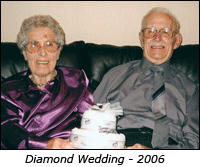 celebrated sixty years of marriage with their Diamond Wedding anniversary. Friends and family made this a memorable occasion for them both.
celebrated sixty years of marriage with their Diamond Wedding anniversary. Friends and family made this a memorable occasion for them both.
It was only during the final years of his life when he began to recall and document some of his harrowing experiences as a prisoner of war. Even though it was now over sixty years ago he was able to recall many events in vivid detail. Some of his experiences as a captive are documented in the military service section of this website.
In his 91st year he and Dorothy moved to a new home in Uppermill. It was with some sadness and reluctance for them both to leave the home they had lived in for over forty years and which held so many memories. Despite this they both knew that their new home was more suitable for their needs and that they would be closer to their family.
They both settled in to their new home very well and made new friends and acquaintances but sadly Roy was not able to fully enjoy his new surroundings as in the months that followed he suffered a rapid onset of memory loss and failing health.
Several times over a short period of time he succumbed to serious illness but with remarkable resilience he fought back and each time made a good recovery. However, with each successive illness he became weaker until finally he could fight back no longer. Roy died peacefully at his home on 30th April 2008 shortly before his 93rd birthday. He died as he had lived, with all his family around him.
After a service at Saddleworth Church he was buried in Saddleworth cemetery, a peaceful resting place overlooking the valley in Uppermill and the hills beyond.
During his life, Roy's presence touched the hearts of many. To those closest to him he was a gentle man of great kindness and humility. His memory will always live on.
"Remember me when I am gone away, Gone far away into the silent land;
When you can no more hold me by the hand, Nor I half turn to go, yet turning stay.
Remember me when no more day by day You tell me of our future that you planned:
Only remember me; you understand It will be late to counsel then or pray.
Yet if you should forget me for a while And afterwards remember, do not grieve:
For if the darkness and corruption leave A vestige of the thoughts that once I had,
Better by far you should forget and smile Than that you should remember and be sad."
Christina Rossetti
